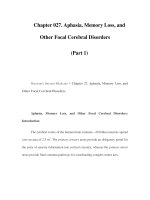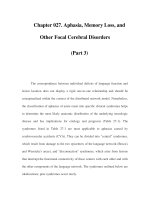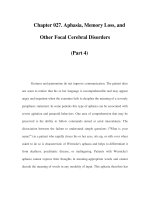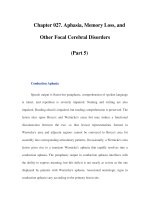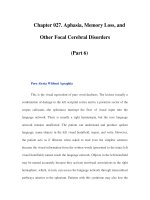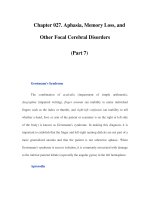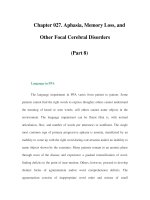Chapter 031. Pharyngitis, Sinusitis, Otitis, and Other Upper Respiratory Tract Infections (Part 1) ppt
Bạn đang xem bản rút gọn của tài liệu. Xem và tải ngay bản đầy đủ của tài liệu tại đây (13.41 KB, 5 trang )
Chapter 031. Pharyngitis, Sinusitis, Otitis, and Other
Upper Respiratory Tract Infections
(Part 1)
Harrison's Internal Medicine > Chapter 31. Pharyngitis, Sinusitis, Otitis,
and Other Upper Respiratory Tract Infections
Pharyngitis, Sinusitis, Otitis, and Other Upper Respiratory Tract
Infections: Introduction
Infections of the upper respiratory tract (URIs) have a tremendous impact
on public health. They are among the most common reasons for visits to primary
care providers, and, although the illnesses are typically mild, their high incidence
and transmission rates place them among the leading causes of time lost from
work or school. Even though the minority (~25%) of cases are caused by bacteria,
URIs are the leading diagnoses for which antibiotics are prescribed on an
outpatient basis in the United States. The enormous consumption of antibiotics for
these illnesses has contributed to the rise in antibiotic resistance among common
community-acquired pathogens such as Streptococcus pneumoniae—a trend that
in itself has had an enormous influence on public health.
Although most URIs are caused by viruses, distinguishing patients with
primary viral infection from those with primary bacterial infection is difficult.
Signs and symptoms of bacterial and viral URIs are, in fact, indistinguishable.
Because routine, rapid testing is neither available nor practical for most
syndromes, acute infections are diagnosed largely on clinical grounds. Thus the
judicious use of antibiotics in this setting is challenging.
Nonspecific Infections of the Upper Respiratory Tract
Nonspecific URIs are a broadly defined group of disorders that collectively
constitute the leading cause of ambulatory care visits in the United States. By
definition, nonspecific URIs have no prominent localizing features. They are
identified by a variety of descriptive names, including acute infective rhinitis,
acute rhinopharyngitis/nasopharyngitis, acute coryza, and acute nasal catarrh, as
well as by the inclusive label common cold.
Etiology
The large assortment of URI classifications reflects the wide variety of
causative infectious agents and the varied manifestations of common pathogens.
Nearly all nonspecific URIs are caused by viruses spanning multiple virus families
and many antigenic types.
For instance, there are at least 100 immunotypes of rhinovirus (Chap. 179),
the most common cause of URI (~30–40% of cases); other causes include
influenza virus (three immunotypes; Chap. 180) as well as parainfluenza virus
(four immunotypes), coronavirus (at least three immunotypes), and adenovirus (47
immunotypes) (Chap. 179).
Respiratory syncytial virus (RSV) also accounts for a small percentage of
cases each year, as do some viruses not typically associated with URIs (e.g.,
enteroviruses, rubella virus, and varicella-zoster virus). Even with sophisticated
diagnostic and culture techniques, a substantial proportion (25–30%) of cases have
no assigned pathogen.
Clinical Manifestations
The signs and symptoms of nonspecific URI are similar to those of other
URIs but lack a pronounced localization to one particular anatomic location, such
as the sinuses, pharynx, or lower airway.
Nonspecific URI is commonly described as an acute, mild, and self-limited
catarrhal syndrome, with a median duration of ~1 week. Signs and symptoms are
diverse and frequently variable across patients.
The principal signs and symptoms of nonspecific URI include rhinorrhea
(with or without purulence), nasal congestion, cough, and sore throat. Other
manifestations, such as fever, malaise, sneezing, and hoarseness, are more
variable, with fever more common among infants and young children.
Occasionally, clinical features reflect the underlying viral pathogen;
myalgias and fatigue, for example, are sometimes seen with influenza and
parainfluenza infections, while conjunctivitis may suggest infection with
adenovirus or enterovirus.
Findings on physical examination are frequently nonspecific and
unimpressive. Between 0.5 and 2% of colds are complicated by secondary
bacterial infections (e.g., rhinosinusitis, otitis media, and pneumonia), particularly
in high-risk populations such as infants, elderly persons, and chronically ill
patients.
Secondary bacterial infections are usually associated with a prolonged
course of illness, increased severity of illness, and localization of signs and
symptoms.
Purulent secretions from the nares or throat have often been used as an
indication of sinusitis or pharyngitis. However, these secretions are also seen in
nonspecific URI and, in the absence of other clinical features, are poor predictors
of bacterial infection.


